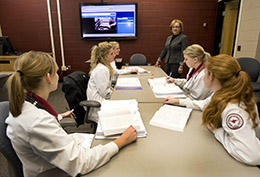 On Friday, December 9, the IUP Department of Nursing and Allied Health Professions will introduce Red Yoder, Carl Shapiro, and Tamara Clark.
On Friday, December 9, the IUP Department of Nursing and Allied Health Professions will introduce Red Yoder, Carl Shapiro, and Tamara Clark.
However, you probably won’t see their biographies on the IUP website.
Red, Carl, and Tamara are residents of the new Nursing and Allied Health Professions Simulation Laboratory, located on the ground floor of IUP’s Donna D. Putt Hall.
IUP will formally “cut the ribbon” for the new facility at 10:30 a.m. Friday. It will be open to the public from 10:00 a.m. to 5:00 p.m.
This new simulation laboratory is designed especially to help prepare nursing students for careers in home health care. One of the areas in the laboratory is Red’s “apartment,” which includes a telehealth system. Telehealth allows the patient to work with a monitor at home that transmits health information to the home health care agency.
The simulation laboratory also includes training on electronic medical records.
Department chair Elizabeth (Lisa) Palmer was successful in 2010 in securing a $299,890 federal grant to create the new laboratory. She is the project director, and Julia Greenawalt, assistant chair, is co-director.
“Because of a shortage of nurses, there are an increasing number of home health care patients, especially in the rural areas, who are monitored by telehealth systems,” Palmer explains. “This simulation equipment enhances undergraduate nursing education with opportunities to practice nursing care using electronic documentation and telehealth services prior to a student’s on-site experiential work.
“The new simulated laboratory will advantage IUP students because a telehealth nurse must not only receive data from patients, but learn how to work with patients in the home.”
The Putt lab manikins are designed with programs to mimic a rural patient with a common chronic illness, such as chronic obstructive pulmonary disease, hypertension, or obesity.
During the open house, visitors will “meet” Red in his “home” at 11:00 a.m. At noon, visitors can observe a critical care situation with Carl. At 1:00 p.m., Tamara will be examined after having a baby. Then, at 2:00 p.m., Red is in need of additional care.
In addition to the simulations, tours of the new facility are available throughout the day, and visitors can also check their own blood pressure at a kiosk.
The department introduced its first simulation laboratory in 2007. This lab, in Johnson Hall, was renovated and expanded in 2009 and includes nine adult manikins, two adolescent manikins, a pediatric manikin, and other training equipment. (This lab has two hospital rooms that are so accurate in their resemblance to a real hospital setting that the lab was used by a national recording artist as the site for a music video!)
The best thing about these labs is that they are in constant use by students and faculty members. Nursing majors are initiated into use of the lab with medium-fidelity manikins in their sophomore year, and “by their senior year, our nursing students have become very skilled with hands-on care,” Palmer said. In addition to the hands-on experience, the entire class has an excellent learning opportunity when it watches the simulation from the observation room.
Our nursing students continue to excel. For example, IUP’s pass rate for the NCLEX, the national exam for nurses, is 96.1 percent for first-time test takers, compared to a national average of 87 percent. They also are in high demand by employers in all types of health care.
So, come congratulate them Friday and learn more about how our nation’s future nurses are being trained. I think you’ll breathe a little easier, thinking about your health care future.
 Phi Kappa Phi, the oldest, largest, and most selective all-discipline honor society in the nation, honored its IUP chapter as a “Chapter of Excellence” in November.
Phi Kappa Phi, the oldest, largest, and most selective all-discipline honor society in the nation, honored its IUP chapter as a “Chapter of Excellence” in November.
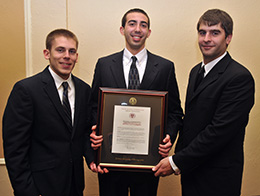

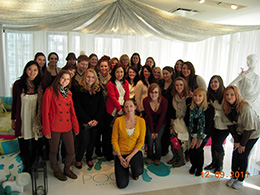

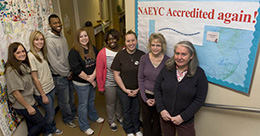
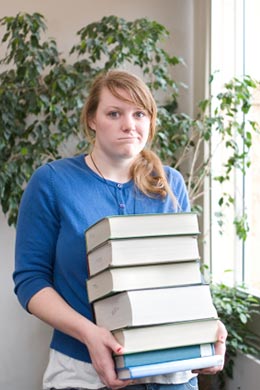 IUP’s
IUP’s  I was delighted to receive this photo from Theresa McDevitt, a
I was delighted to receive this photo from Theresa McDevitt, a 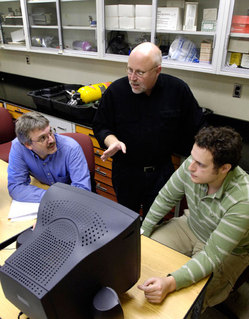
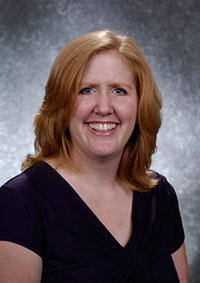 Criminology professor
Criminology professor 